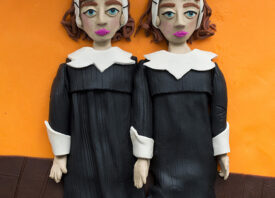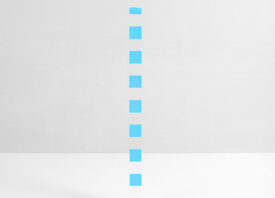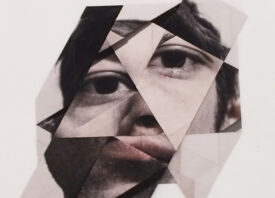Search this site
Photographer Recreates Disasters and Accidents Involving Shipping Containers

01. Untitled. (New Orleans, Louisiana, September 10, 2005). 2010. 36 x 48 inches.
My ongoing investigation of shipping container disasters is based on images found on the internet. The found image becomes a template used to create a sculpture that is constructed for the production of a new photograph. Each sculpture appears hastily made, with visible tape and staples, showing a temporary and fragile structure.
My works are titled with the place and date of the accident, relating the new photograph to the original event. By abstracting the scene from its original context and placing the damaged containers onto a seamless background, these objects become patterns of color and shape, leaving a ghostly interpretation of a disastrous event. From this process a temporary sculpture exists in addition to the photographic work.—Heather Rasmussen
We recently asked Los Angeles-based photographer Heather Rasmussen some questions about her recent series DeconstructConstruct, in which she makes small-scale reproductions of shipping container disasters—container vessels at sea, stacked containers in shipyards, floating cargo containers dispersed by hurricanes or tsunamis, cargo train accidents—and photographs them.

10. Untitled. (Containeryard, Liverpool, UK, January 13, 2004, flipped) 2012. 40 x 48 inches
Where did the idea for this body of work come from and how do you create the sculptures?
“I grew up in Southern California, and always saw the Port of Los Angeles from the freeway. Initially I used Google Maps to choose the area to build, and then I determined the stacked container height based on the shadows in the image. I created a template out of paper that corresponded to the colors of the containers, and then used this to hand fold each container into an empty box.
“During this time I was also searching the internet for images of shipping containers, and happened upon disasters and accidents on ships and on land. I started collecting these images and now have a huge archive of shipping container accidents. In 2008 I decided to use the paper containers to replicate found disaster images, and then photograph them with a 4×5 film camera.”

08. Untitled. (Goods Train, Lismore Victoria, Australia, May 26, 2006). 2010. 30 x 39 inches
The images seem simultaneously playful yet sinister. Is this tension important to you?
“I think this tension is very important. In reality when a shipping container accident occurs, hundreds of thousands of dollars of goods are lost, people may be dead or injured, and the pollution from many of these occurring at sea is awful. Containers are 20 or 40 feet long, and made out of steel, so it is amazing to see them mangled and crushed simply from bad weather. The images I create from these accidents are definitely colorful and playful. My containers are to scale at one inch = 10 feet, which means that my paper containers are either two or four inches long. At first glance, they could be children’s blocks or toys. I enjoy finding beauty in disastrous situations.”

09. Untitled. (Ever Decent, English Channel, August 24, 1999) 2011. 30 x 39 inches

07. Untitled. (Port of Sendai, Japan, March 13, 2011). 2011. 20 x 28 inches

06. Untitled. (Osprey Lines Barge, Mississippi River gulf canal, January 2002). 2009. 20 x 26 inches

05. Untitled. (M/V Jeppesen Maersk, Gran Canaria, November 25, 2006). 2009. 30 x 39 inches

04. Untitled diptych (MV Rena, Astrolabe Reef, New Zealand, October 28, 2011) 2012. 30 x 40 inches

03. Untitled diptych (MV Rena, Astrolabe Reef, New Zealand, October 28, 2011) 2012. 30 x 40 inches

02. Untitled. (stacks diptych, date and location unknown) 2011. 37.5 x 30 inches each.
This post was contributed by photographer Siri Kaur.



